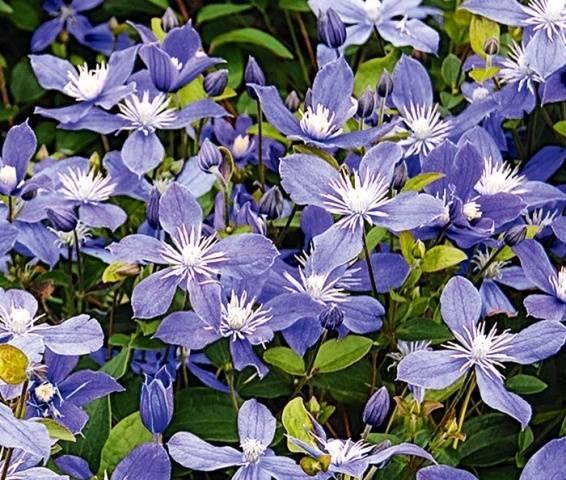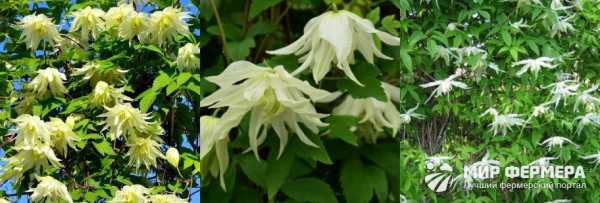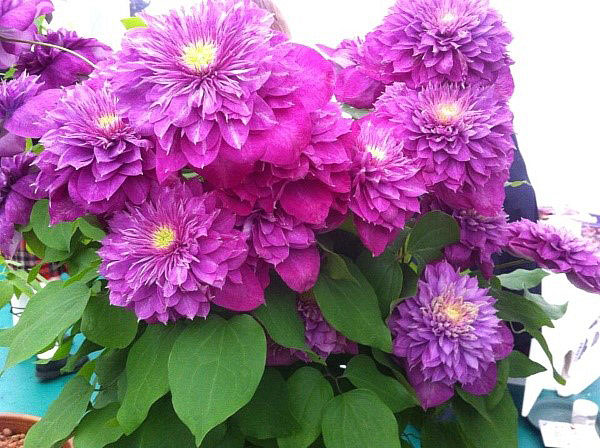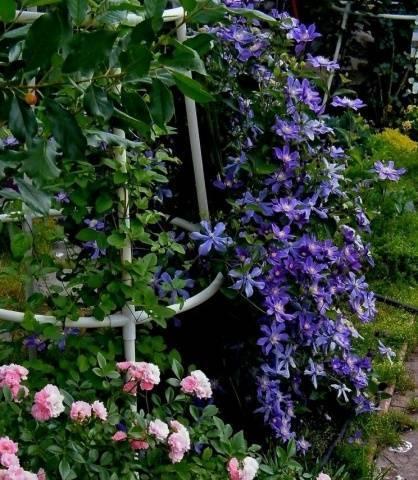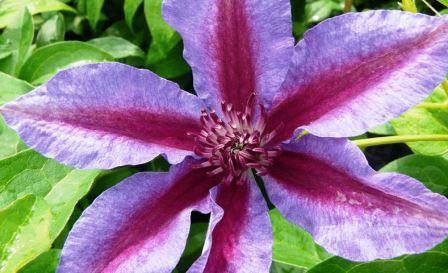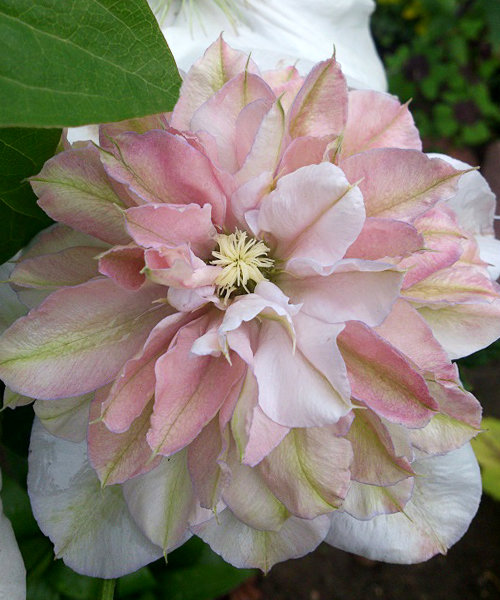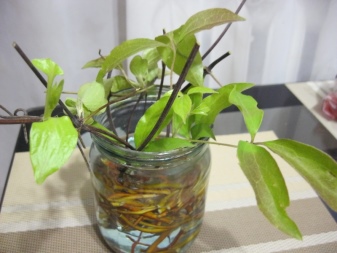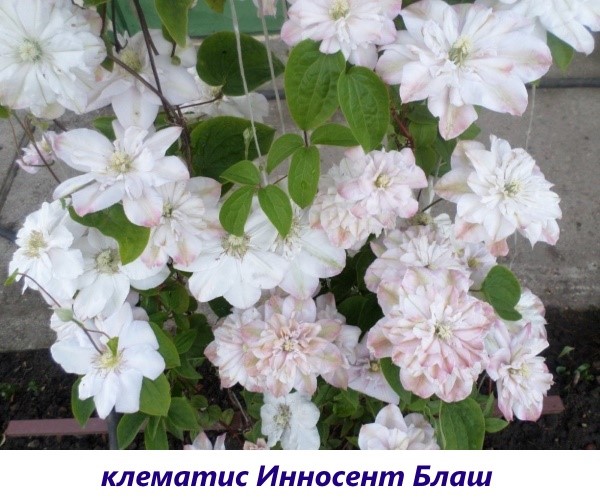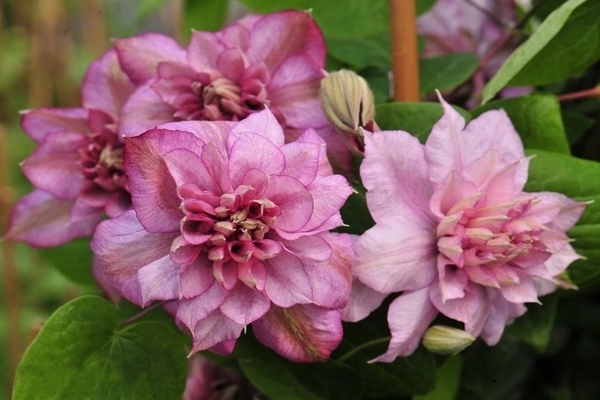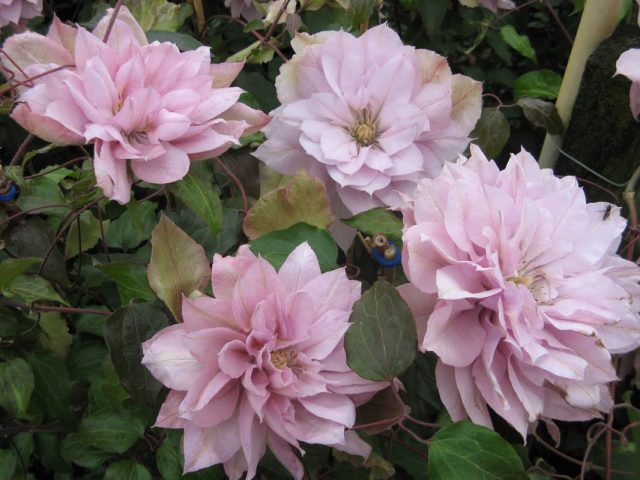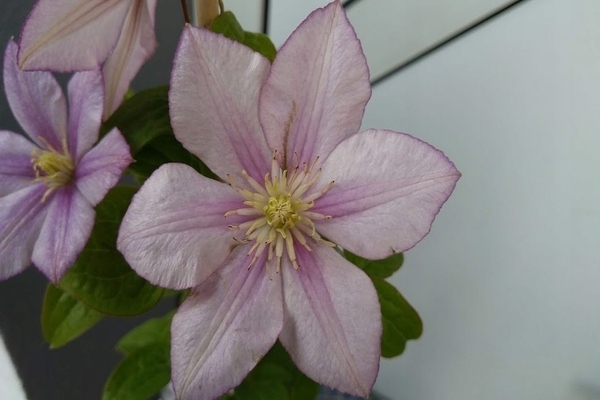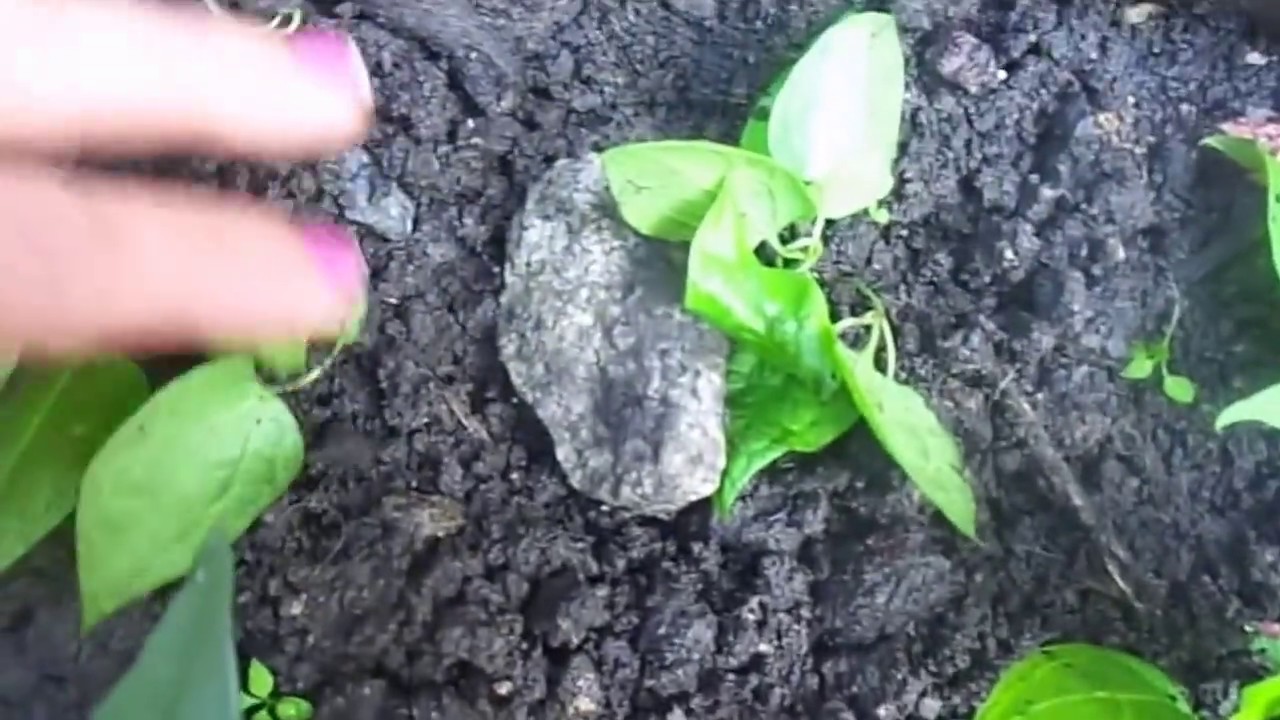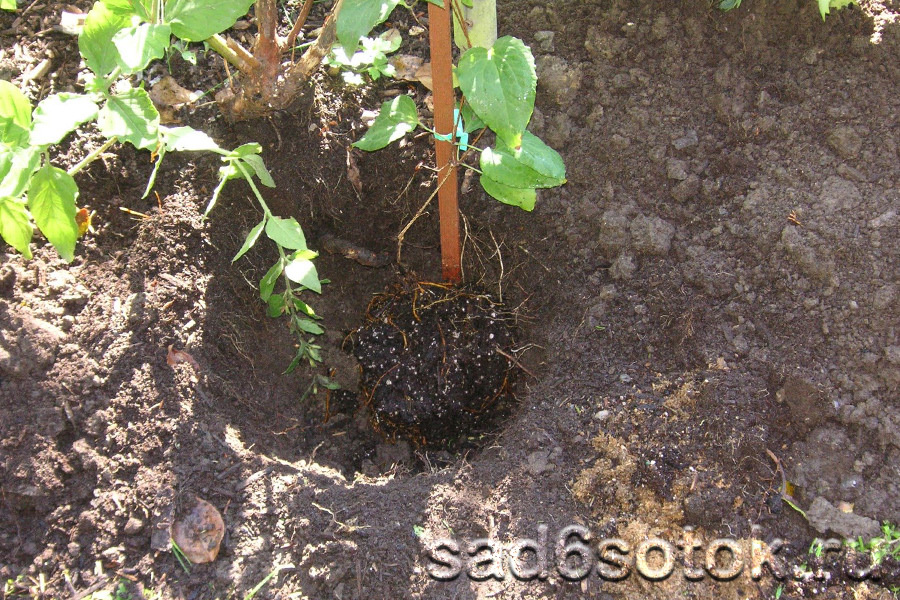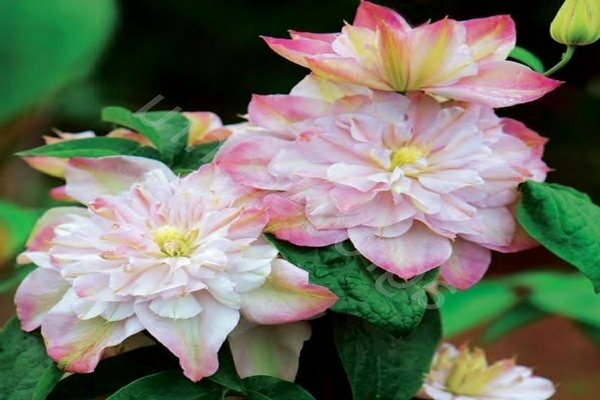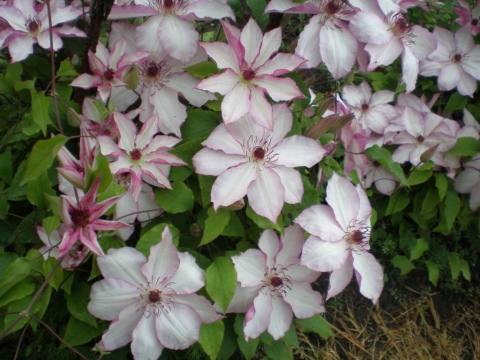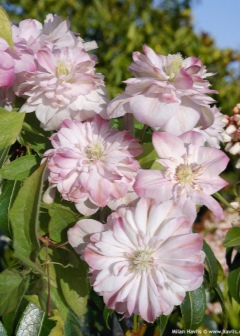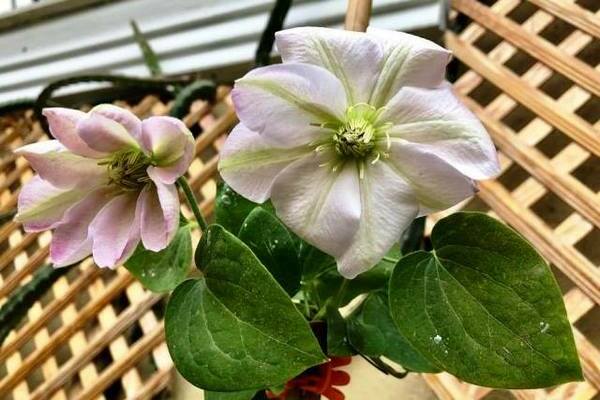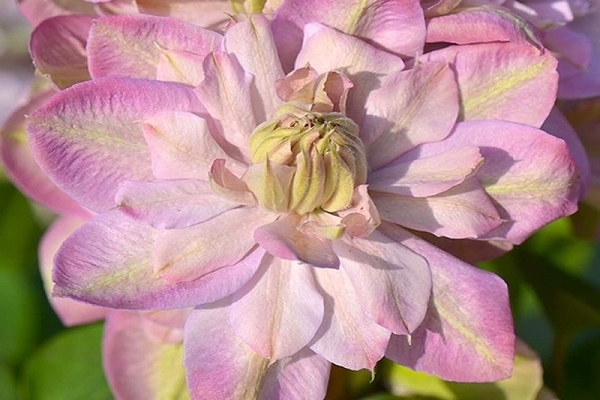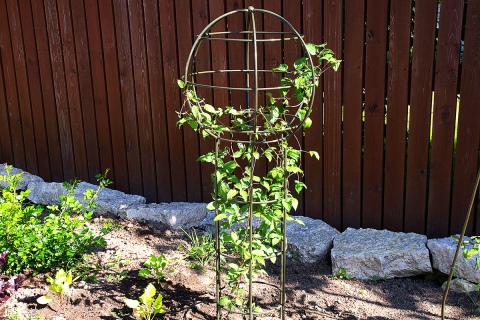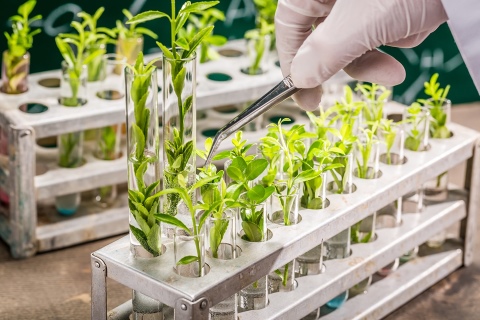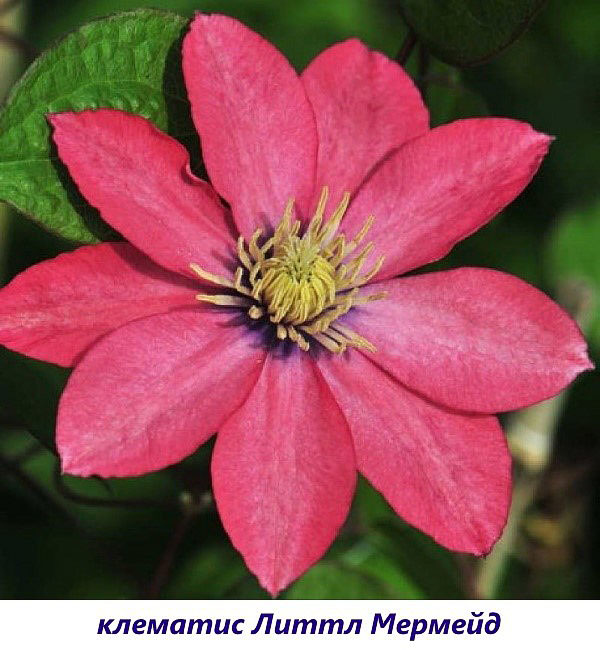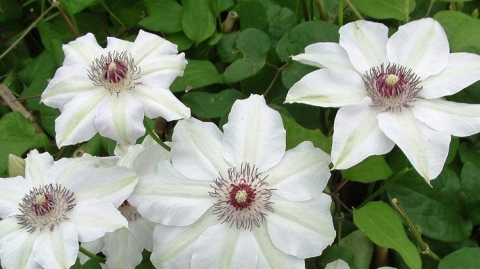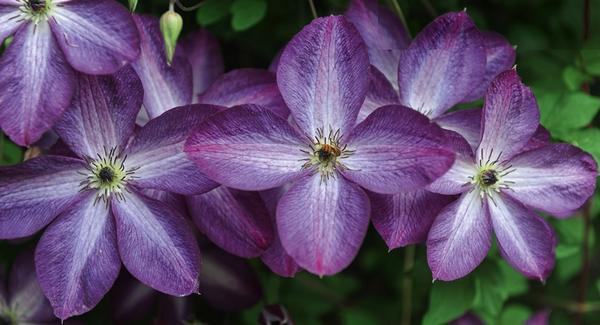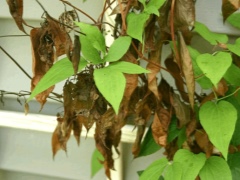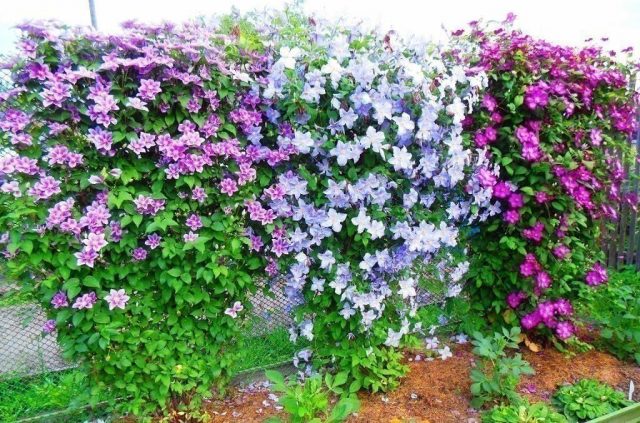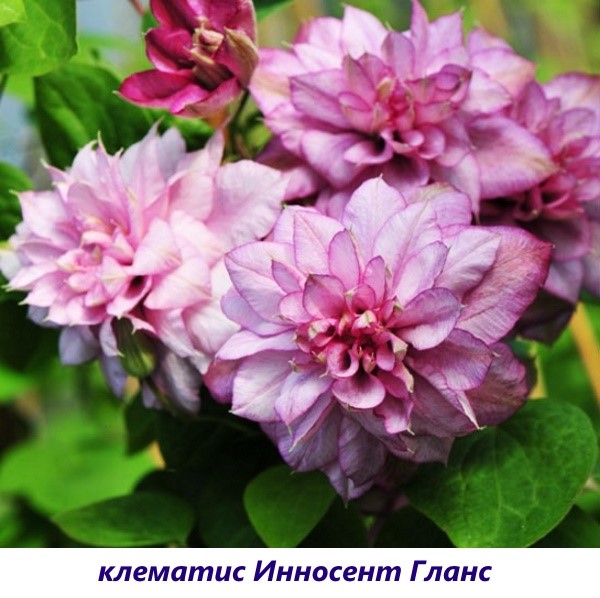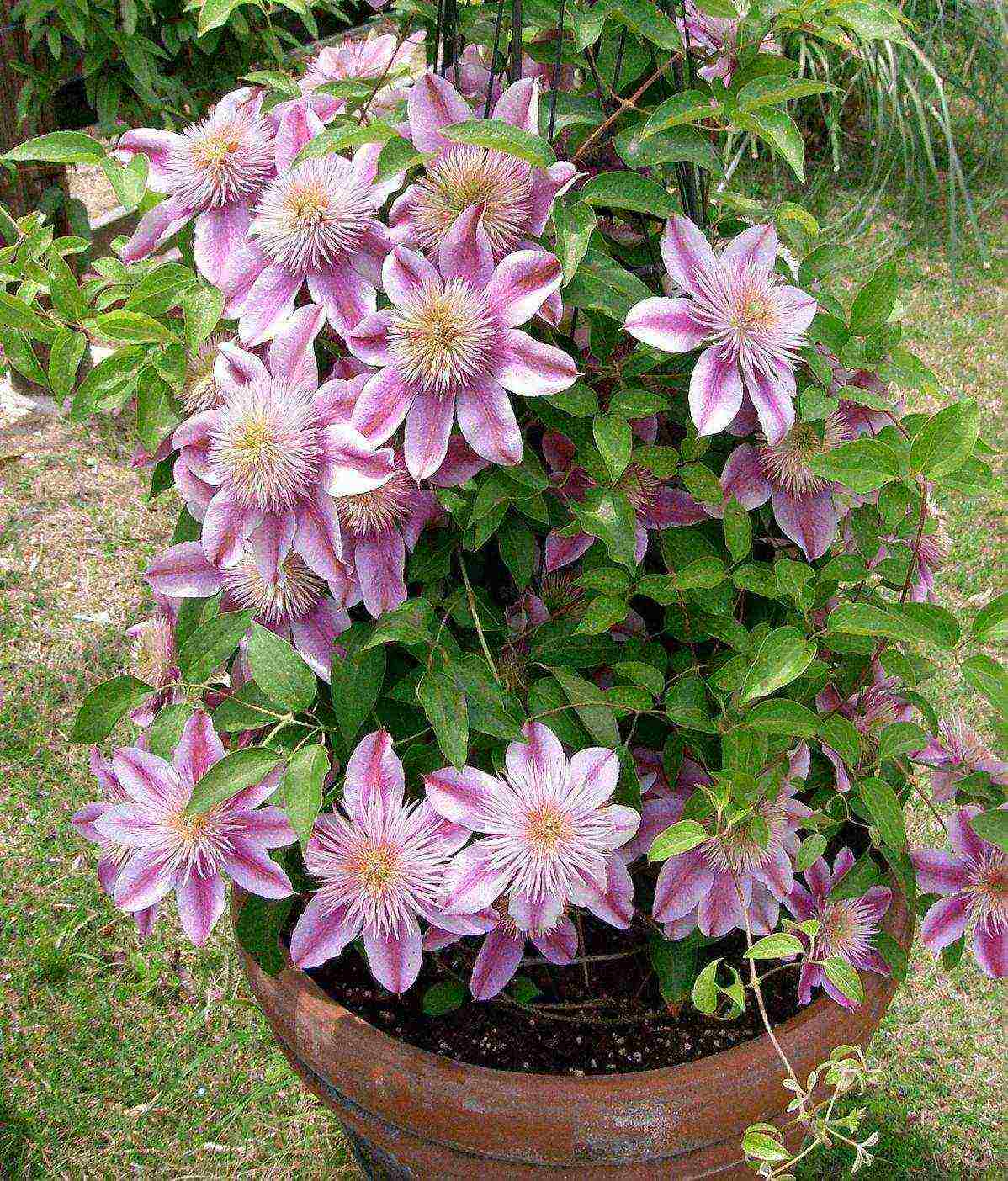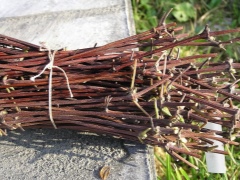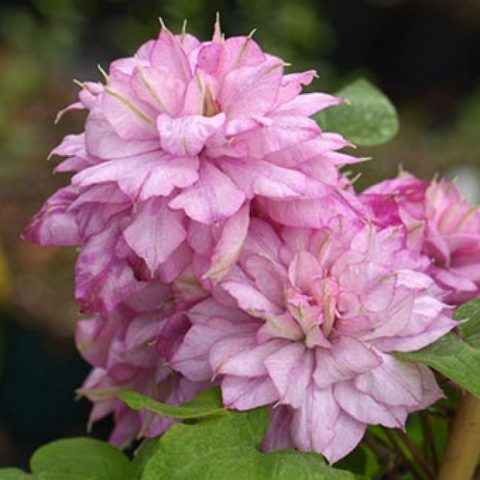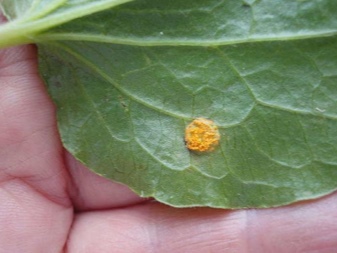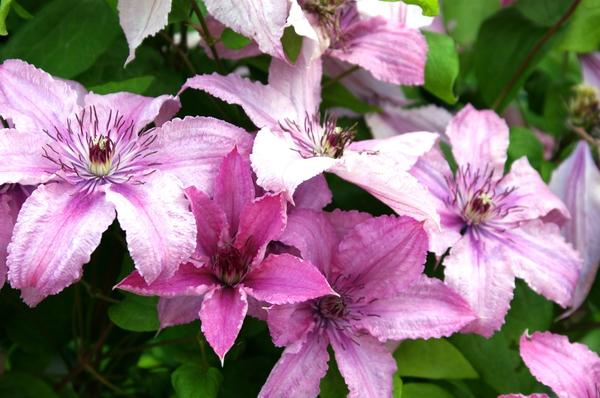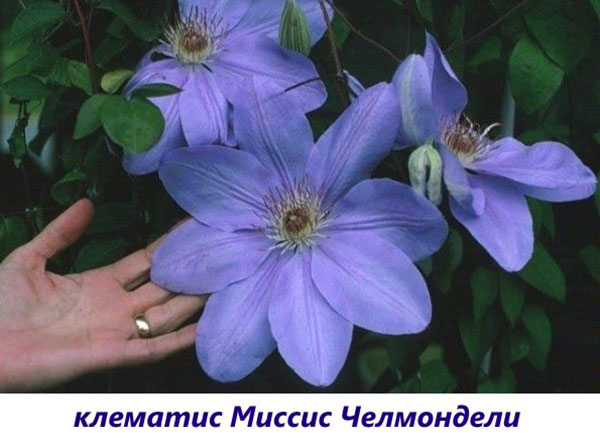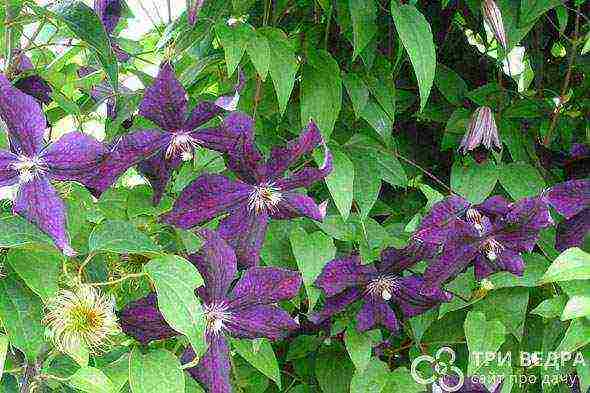Reproduction of clematis by dividing the bush and layering
There are several ways of breeding clematis, each of them is described below.
The division of the bush is used if the vine has grown, or when it is forced to transplant it to a new place. When clematis propagates by dividing the bush, a well-developed healthy bush (at the age of 4 - 5 years) is divided in early spring, before the shoots begin to grow. The plant is cut so that each division has 2 - 3 buds and a sufficient root system. In this case, 2 - 3 plants are obtained, which bloom in the same year.
When planting divisions, the soil (pits) are prepared in the same way as when planting bushes, and before planting they are watered with a solution of "Heteroauxin" (1 tablet per 3 liters of water, consumption per plant is 2-3 liters of solution). After 7-8 days, watering the soil around the plants with this solution, repeat. Often bought clematis saplings after planting are difficult to grow, I recommend pouring a solution of "Heteroauxin".
Reproduction of clematis by layering also gives a good result. In June, a groove is made from the base of the bush with a depth of 6-7 cm and a length equal to the length of the shoot, into which a young stem is laid, the top is left outside. Its nodes are covered with fertile soil, and all the leaves on the buried shoots are left outside. The ground in it should always be moist. Layers should be fed 2-3 times (dilute 1 teaspoon of urea, potassium sulfate and superphosphate for 10 liters, and add 1 tablespoon of Agricola Start).
By the fall, roots are formed in almost every node. In the spring of next year, shoots will go from most of the nodes, however, young plants should not be divided and transplanted until autumn (September). In the fall, the layers are separated from the mother plant, separated by rooted nodes and planted in place. Most often, these plants bloom in the first year. The buds at this moment need to be pinched.
3rd group
Allanah (Allana) has large (up to 20 cm) deep pink flowers with a dark wide stripe. It is characterized by growth from 1 to 2 m and long flowering from June to September.
C. aromatica (K. aromatic) is a profusely flowering small variety with dark blue flowers on rising stems up to 1.5 m.
C. diversifolia "Heather Herschell" blooms during the second half of summer and early autumn. On a plant up to 2 m, small pink flowers in the form of bells gradually open.
Anita (Anita) - a hybrid of Tangut clematis with many white flowers (VII - IX). 3 - 4 m.
Arabella (Arabella). All summer long, the 2-meter bush is covered with small flowers that change color from blue-violet to blue.
Ashva (Ashva) up to 1.5 - 2 m in height. Flowers - 10 - 12 cm, bright lilac with a reddish stripe, appear from June to autumn cold weather.
Avant Garde (Vanguard) - an unusual variety with flowers about 4 - 5 cm in diameter. Sepals are wide, cherry-colored, the middle is made of pale pink staminodes.
Barbara (Barbara) - one of the few representatives of the group that has large flowers (up to 15 cm). The bush is abundantly covered with them throughout the summer. The shade is reddish pink.
Betty Corning (Betty Corning) - liana up to 4 m tall. The flowers are bell-shaped, lilac-lilac with veins and wavy lapel edges.
Bieszczady (Bieszczady) EARTHQUAKE literally translates as "earthquake". Named for the mountains in the east of the Carpathians. Despite belonging to group 3, the variety has flowers up to 20 cm in diameter, pink with a white stripe. They appear on the bush from June to September.
C. Integrifolia Blue Sensation is covered with 6-8 cm purple-blue flowers throughout the summer. The average height is 1.2 m.
Carmencita (Carmencita). This 3-meter cultivar is characterized by wide crimson flowers with diamond-shaped petals. Unpretentious, blooms for a long time and abundantly.
Change of Heart (Change of Hart, "Transformation of the heart") got its name due to the change in the color of flowers from pink to pale lilac. Differs in lush flowering from May to July.
Cloudburst (Cloudburst) from English - "downpour", which accurately conveys the abundance of purple flowers with a white center and black stamens on its background. Growth - up to 3 m.
Comtesse de Bouchard (Comtesse de Bouchard, Countess of Bouchard) has broad pink flowers of moderate size. They open all summer on powerful (up to 4 m) bushes.
Crispa Angel The word "crispa" - "ribbed" - conveys the graceful wavy shape of neat bell-shaped flowers about 4 cm in diameter. This Japanese variety of clematis blooms from July to September.
Duchess of Albany (Duchess of Albany - "Duchess of Albany") is an original variety with cups in the form of tulips. They are bright pink with longitudinal stripes, open from the second half of summer to early autumn.
Etoile Violette in French means "Purple Star". It blooms for a long time and abundantly on 3-meter shoots.
C. heracleifolia "Cassandra" (K. hogweed "Cassandra") forms bright lilac-blue clumps blooming throughout the summer due to rising stems up to 1 m long.
Mazowsze VOLCANO is beautiful with velvet cherry petals. The diameter of the flowers is up to 20 cm.
Mme Julia Correvon (Madame Julia Correvon) blooms all summer with cherry bells on vines up to 4 m.
Purpurea Plena Elegance (Purpurea Plena Elegance) is a light-loving cultivar with numerous double crimson flowers. Unpretentiousness and long flowering allow both amateurs and professionals to grow the variety. Height - about 3 m.
Sweet Summer Love (Sweet Summer Love - "Sweet summer love) - a unique variety with fragrant purple flowers up to 4 cm in diameter. An avalanche of color covers the high (3.5 m) bush all summer.
Taiga (Taiga) - a new clematis with fully double flowers up to 7 cm, reminiscent of hedgehogs. The sharp tips of each petal are greenish-white, the main shade is blue.
Clematis Innocent Blush: variety description

Clematis Innocent Blash: photo
Many gardeners classify all types of clematis as special varieties of garden plants. After all, the flowers of this variety have a special beauty. The world of clematis is the world of vines, which include a large number of hybrid varieties with bright colors. Clematis Innocent Blush is a type of classic clematis that has beautiful, light-colored flowers. Large-flowered Clematis Innocent Blush is a liana shrub of the variety that is used to decorate verandas, terraces, gazebos and hedges. Creeping shoots are able to twine around various structures, while creating a unique atmosphere. The variety was bred by Polish breeders and is a hybrid variety. The plant has appeared on the free market since 2012. It differs in its peculiar features, belongs to the 2nd type of pruning. Shoots of clematis Innocent Blush can reach a height of up to 2 m, while the support should be no more than 1.5 m high.It is by clinging to the support that the plant will grow and develop. The diameter of the flowers of large-flowered clematis Innocent Blush can reach 18 cm, most often one flower can have up to 6 sepals; the middle of the flower has yellow stamens. A feature of the variety is its ability to bloom twice throughout the season. The color of the petals can be absolutely any: from light pink to light purple with pink edges. Innocent Blush is a large-flowered hybrid, the diameter of the smallest flowers is 10 cm. It blooms on last year's shoots. The flowers are large and pink in color. The core petals of Innocent Blush clematis are short in length, but elongation occurs at the edges. This characteristic feature of the plant gives volume to the flower.
Clematis Etual Violet: planting and care
An important stage in the cultivation of Etual Violet clematis is the right choice of a place for planting. Clematis of the Etual Violet variety requires a site protected from gusts of wind. This hybrid crop grows and develops better in good light conditions, for this reason it is better to choose a southern or southwestern exposure of plantings.
Clematis Etoile Violet can grow quite calmly in the light shade that other crops form. However, a minimum of five hours of sun exposure is required for the plant to thrive and bloom profusely.
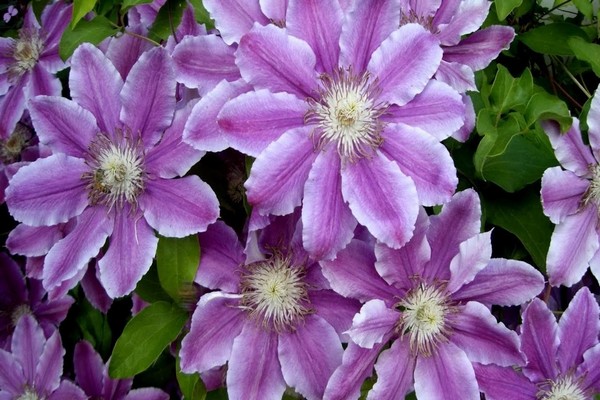
Clematis Etual Violet: photo
As for the soil, it must contain a sufficient amount of nutrients. The soil must pass moisture well, as well as oxygen. It is preferable to choose loam with a loose structure for planting clematis. Clematis Etual Violet will feel very bad on too salty or acidic soil. In such conditions, clematis will develop and grow poorly, and will often be subject to various diseases. Such a plant will bloom too little, and the flowers will be small.
Planting clematis Etual Violet in the ground is carried out twice a year: in the spring and autumn. Before planting the seedling directly into the soil, it is recommended to soak the root system of the plant for one hour in special solutions of a growth stimulant and a fungicidal preparation. The landing pit has the same size in all respects - sixty centimeters.
After the hole for the plant has been dug, it is necessary to add additional nutrition. A drainage layer is laid at the bottom (fifteen centimeters), then wood ash comes (one liter). After that, you need to fertilize. For this, humus in the amount of one bucket per pit and fertilizer based on mineral elements (about one hundred grams) are suitable.
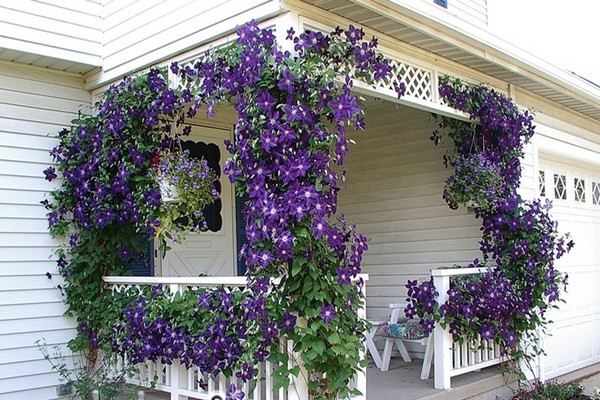
Clematis Etual Violet: photo
On the side on both sides of the hole, you need to install trellis for clematis shoots Etual Violet. A mound needs to be formed in the center of the planting pit, a seedling is installed on top, the root system needs to be straightened. At the same time, the root collar should be above the ground, at least five centimeters. Then the seedling is covered with soil, after which the plant must be thoroughly watered. The water should not be cold.
As for further care, this culture does not show any special requirements. In the area of the trunk circle, you need to get rid of weeds from time to time. In addition, you need to periodically loosen the soil, so, thanks to the supplied oxygen, the root system will not hurt. To make it less likely to weed the area, as well as water the clematis, you can lay a mulching layer. For this, sawdust and peat work well.
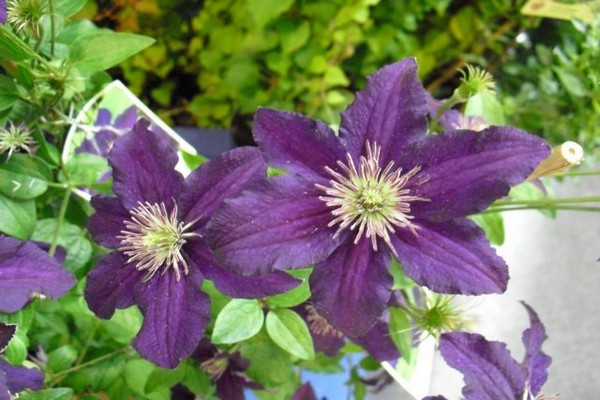
Clematis Etual Violet: photo
Clematis Etual Violet is quite picky about soil moisture. If there is not enough water for the plants, then the flowers become too small, and their number also decreases. If the weather is stable, then you need to irrigate the plants once every couple of days, when the sun's rays are not so aggressive. This is best done in the evening after sunset. One adult plant requires a minimum of two buckets of water. One bucket will be enough for a young clematis Etual Violet. At the same time, the water should be warm and settled for at least a couple of days.
From time to time, you need to add additional nutrition to your flowering vines. This has a beneficial effect on the flowering of Etoile Violet clematis. In the first year, the plants draw their nourishment from reserves that have been deposited in the planting holes. This amount of fertilizers is enough for the first time. After the plants have overwintered, you need to feed them in the spring and summer. It is best to alternate organic fertilizers with fertilizers based on mineral elements. Once a month, it will not be superfluous to process clematis by foliar method.
Clematis Etual Violet grows quite intensively, so the shoots must be fixed to the installed trellis. This clematis will be a wonderful decoration for arches, arbors, fences. The design of the trellises should be strong enough, since such a plant gives a lot of green mass. For these purposes, many experienced florists prefer metal structures in the form of nets and pipes.


